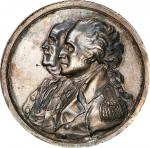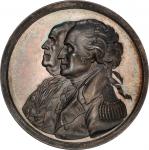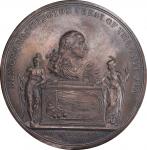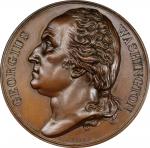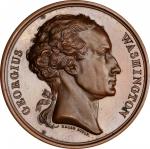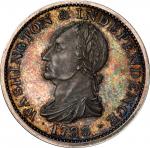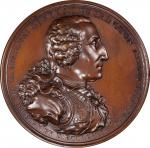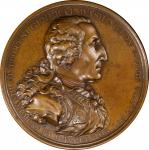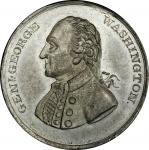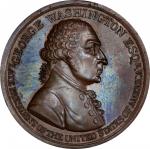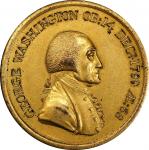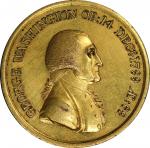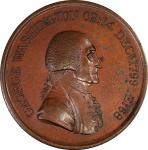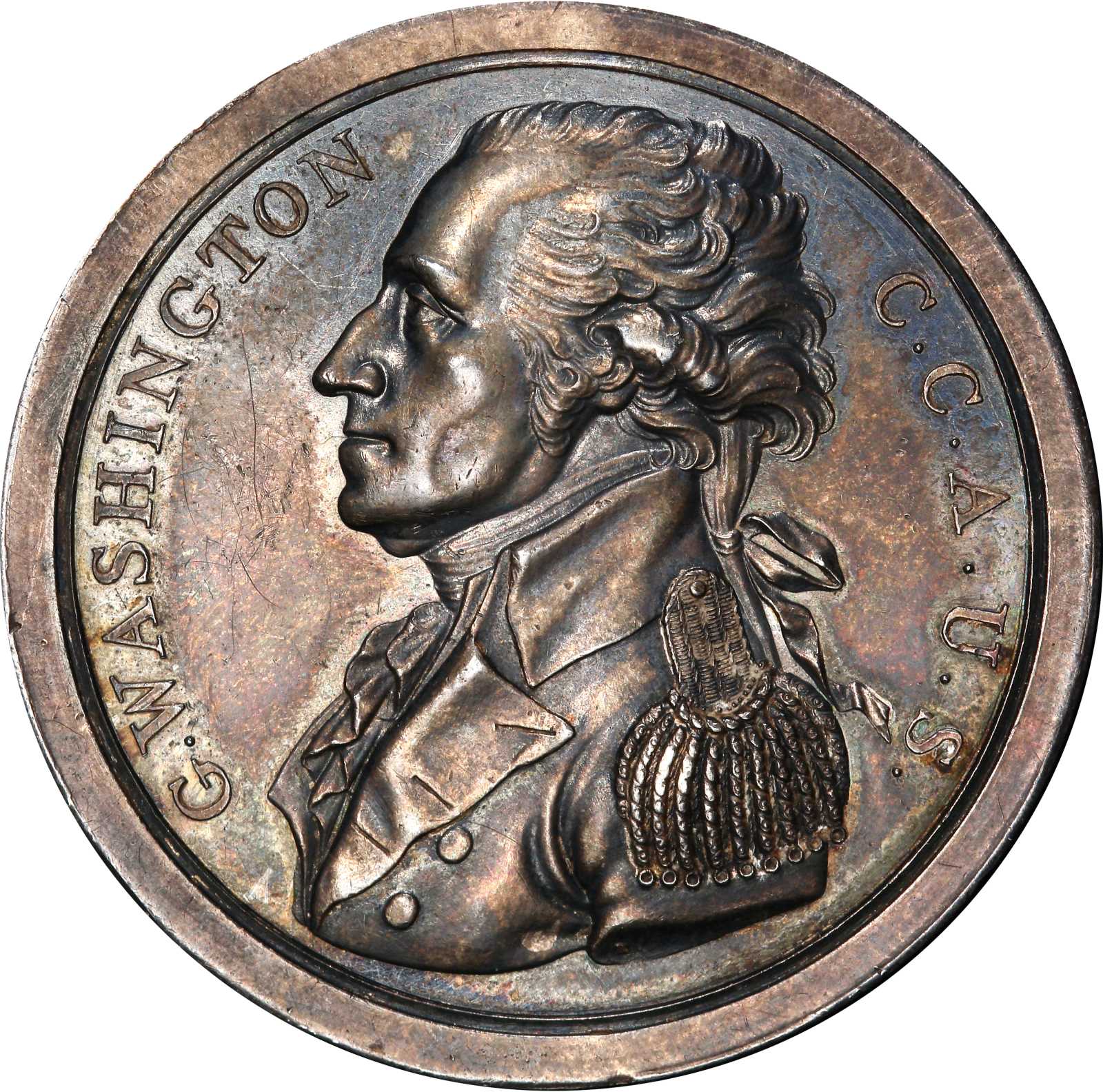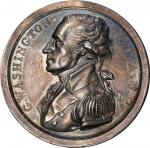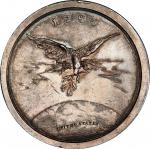1805 C.C.A.U.S. (Commander in Chief, Armies of the United States) medal. Musante GW-90, Baker-57, Julian CM-6. Silver. SP-58 (PCGS).40.7 mm. 571.5 grains. The obverse is deeply toned dark bluish-gray with highlights of deep golden brown evident upon more prolonged study. Though a bit subdued on this side, reflectivity is still seen in the fields, strongest in the recesses of the legends and outlining Washingtons beautifully rendered portrait.
A few light handling scuffs and hairline scratches are noted in the fields, mostly at left. The reverse was the more protected side in Bakers cabinet, and is quite a bit lighter in tone. Pearlescent medium gray is accented by gentle mottling of olive and pale blue. As on the obverse, the recesses glitter with prooflike reflectivity, but more intensely so. A few small rim nicks are seen on this side, most notably near 12:00, while the fields show pairs of marks left of the olive branch and above the right side of the globe. A sharp example of this elegantly designed and distinctive medal, whose dies were engraved by the talented John Reich. His mark "R." is seen at the truncation of Washingtons shoulder. No collaring mark is seen on the edge. At 6:00, there is a small natural depression on the edge that precluded the full execution on the rims of both sides. As such, what appear as tiny nicks on the rims are really just the result of a tiny planchet imperfection. The Baker number is on the edge in red.
As discussed in our earlier presentation of Joseph Sansoms Presidency Relinquished medals (GW-58), this is the first of his planned series of medals celebrating the History of the American Revolution. It seems that he completed four in his series, while a couple of additional mulings were created at the Mint later. This was the beginning, and its date of accomplishment is fairly well documented. Sansom presented an example to President Thomas Jefferson, accompanied by his explanatory letter dated December 28, 1805, the same day that his advertisements announcing the medallic series first appeared in Philadelphia newspapers. Jefferson, a medal collector, responded graciously and was later rewarded with an example of the Presidency Relinquished medal on March 25, 1807, and perhaps others in the series. Jeffersons C.C.A.U.S. medal still resides at Monticello.
The public notice solicited orders for the medal in silver at $5, and in gold at $50, though none in gold has ever been seen. A few were sold or otherwise distributed, as in the case of Jeffersons, but according to Baker, the obverse die broke early and this brought an end to this initial entry in Sansoms series. Indeed, Sansoms own set of the History of the Revolution medals remains intact, and includes no C.C.A.U.S. medal.
The C.C.A.U.S. medal has long been considered a landmark of the Washington series, one that typically only appears in truly remarkable cabinets. We have been able to account for ten distinct specimens, two of which are in institutional collections. Of those in collectors hands, we have handled all but one over the years. The first sale we are aware of was in Bangs, Merwin & Cos March 1865 James R. Chilton sale, where William Sumner Appleton was the buyer. His medal is now in the collection of Massachusetts Historical Society. It is number 1 in our roster. Others are as follows:<p>2. Thomas Jeffersons personal specimen at Monticello.<p>3. Charles I. Bushnell (S.H. and H. Chapman, June 1882, lot 1277); T. Harrison Garrett (Bowers and Ruddy, March 1981, lot 1751). The Rulau-Fuld plate.<p>4. William Spohn Baker (d. 1897); Historical Society of Pennsylvania.<p>5. Matthew Stickney (Henry Chapman, June 1907, lot 414); Henry L. Jewett (S.H. Chapman, June 1909, lot 402); Thomas Elder for Stephen Nagy; Wayte Raymond(?). Plated in his monograph; George Fuld; Glendinings, October 1968; Lucien LaRiviere (Bowers and Merena, November 1999, lot 3047)<p>6. W.W.C. Wilson (Wayte Raymond, November 1925, lot 853); Wayte Raymond; John J. Ford, Jr. (Stacks, October 2004, lot 192).<p>7. Federal Coin Exchange (January 1954, lot 752); John J. Ford, Jr. (Stacks, May 2004, lot 60).<p>8. Norweb Specimen (Stacks, November 2006, lot 2050).<p>9. Charles P. Senter (Wayte Raymond, October 1933, lot 106); Frenchs, May 1970:837 (probably); Richard Picker; Stuart Witham (Bowers and Merena, September 1992, lot 2106); Stacks, March 1993, lot 2009; Stacks 1993 Summer FPL:7.<p>10. Ira and Larry Goldberg, May 2006, lot 3304 (although this lot was not in the print catalog).
We know of several historic appearances of this type in addition to those listed above. Owners included Colin Lightbody, Mendes Cohen, Henry Holland, Isaac Wood, R. Coulton Davis, Harlan P. Smith, and Allison Jackman. Without plates or named catalogs, however, it is all but impossible to tie those appearances to medals we are presently aware of. It is possible that more specimens exist, but if so, the number would undoubtedly be very small. As the list above illustrates, the ownership of a C.C.A.U.S. medal enters ones name into a pretty impressive list of great collectors who have owned specimens in the past. Some well-known collections of old included electrotypes to represent this rare and desired medal. Mickley owned one described as bronzed tin in addition to his silver example, and Bushnell purchased it for his collection. Sylvester Crosby only had electrotype representation of the C.C.A.U.S. medal in his cabinet, but he had <em>two</em> of them.Ex William Spohn Baker Collection, to the Historical Society of Pennsylvania by bequest, November 15, 1897.

